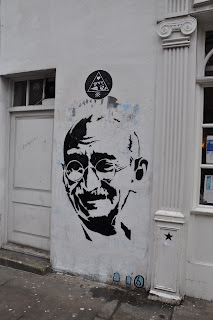TA~DA! After Ridley and Soroya, here is Sen’s post. By the way, I hope you guys could bear my immure English writing.
The four of us really appreciate that we could have such an opportunity to explore the east end. SinceI remember when I first came to CIDA, Toks told me how important and amazing of this area. But east end was just a concept for me that time. Apparently, the best way to access one place is experiencing rather than just google or wekipedia it.
Our first destination is the the whitechapel bell foundry, since it located at the first corner from CIDA office. The foundry is famous as it produced Big Ben and the Liberty Bell and had been seen as the the oldest manufacturing company in UK. An old lady who works there introduced its background and show the exhibition room to us. Unfortunately, the manufacture area does not open to public, so we just see around the exhibition and the gift shop. Anyway, we girls are fond of those exquisite bell souvenirs, such as tolling bells, carillon bells and handbells.

Then we continue our field trip along the Brick Lane, the complex cultural area which could represent the East End. It runs from Spitalfields at the north end woen to Aldgate at the south. So, it seems like we enter it from the south entry. In addition to its fascinating history, the road is known for its various markets which take places every weekend.
The majority restaurants there are Bangladeshi flavor. Curry smell? Ha? We love it and the prices reasonable. Some vintage shops are sprawling the street, add more mystery sense to Brick Lane, try to think that, you are a young lady who eating India food in 1960s!
Here comes the big things in Brick Lane—The paintings on the wall. Pictures first.
Despite the truth that I am a fake fans of street art, I had touched by those paintings. The images are vivid, some of them even like photos. The themes of these paintings including anti-war, environment, Jazz culture, cartoon and so on. We were shocked by the giant paintings of a crane on the wall, and we had been told that had been finished over night. How the artist done this genius job so quickly!
Interesting that some paintings keep changing as Ridley noticed one tiny part of one animal painting is changed after she visited Brick Lane last year.  yeah, this one.
yeah, this one.
Then, it snow, again...We are frozen. But nothing can held our steps to explore the
Soraya and Lihua used their phones to find the location of Old Spitalfields markets. We found the Shroidech High Street Station first and walked back and forth, finally, we found the markets. It was lunch time, the markets was kind of busy. Over 150 stalls operating, offering an impressive array of art, fashion, gifts, antiques and food, they look for something original, of excellent quality and good value for money. Some fashion and modern brands there such as Benefits, Canteen are the good combination of old and new. 
After lunch, we kept find the Petticoat Lane market. It is near Liverpool Street and the scale of this market is much smaller than the previous one and it was sprawling along the street. But we have been told that on Sundays, the market will spreads out much further. The area is well-known for its leather goods, plus you will also find chain store clothes at bargain prices. The prices here remained me the Zoo market in Beijing. You know, its so hard to find the cheaper price in London~~
Then we walked back to Whitechapel Street and
visited the Whitechapel Gallery. The
gallery was founded in 1901 as one of the first publicly funded galleries focus
on temporary exhibitions. For over a centry, the gallery has premiered
world-class artists from modern artists, such as Pablo Picasso, Kackson Pollock
and so on. Lovely display of limited
edition prints by well known and not so well known artists currently on
display. Especially, the exhibition called Aspen Magazine: 1965-1971 showed in
Gallery 4 display some complete sets of rarely seen publications. Issued in a
box, Aspen was one of the first multi -media magazines and became a time
capsule of the period.Although I had to admitted that I can’t understand the
modern art sometimes, I still try to catch the spirit and meanings that the
artists conveyed.

Our last stop is the Muslin area near whitechaple tube station. Exotic but interesting sphere for us. Most of the Whitechapel population are from Bangladesh and it is also a major Islamic area. The street market attracts a very large number of tourists as well. We did not spend much time there, just see around.

It is such a busy and meaningful day for us. Field trip is always the best way to understand an area. Try to touch,feel the history and cultural atmosphere there.
















































.JPG)


.JPG)

.JPG)

